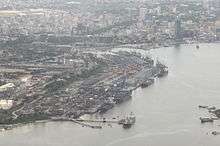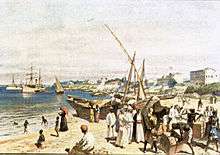Port of Dar es Salaam
| Dar es Salaam Port | |
|---|---|
 | |
| Location | |
| Country | Tanzania |
| Location | Kurasini, Dar es Salaam |
| Details | |
| Operated by | Tanzania Ports Authority |
| Owned by | Government of Tanzania |
| Type of harbor | Natural |
| Available berths | 11 [1] |
| Wharfs | 4 [1] |
| Employees | 2,684 (2012) [1] |
| Port Manager | (Seat Empty) [2] |
| Channel depth | 12m[3] |
| Statistics | |
| Vessel arrivals |
|
| Annual cargo tonnage |
|
| Annual container volume |
|
| Value of cargo |
|
| Passenger traffic |
|
|
Website www | |
The Port of Dar es Salaam is the principal port serving Tanzania.[6] The port is one of three ocean ports in the country and handles over 90% of the country's cargo traffic.[1] According to the International Association of Ports and Harbors, it is the fourth largest port on the African continent's Indian Ocean coastline after Durban, Mombasa and Maputo.[4] The port acts as a gateway for commerce and trade for Tanzania and numerous bordering landlocked states. For years the inefficiencies at the port has cost the regional economy millions of dollars; in 2012 the total global welfare loss caused by the inefficiencies of the port stood at US$1.8 billion for the Tanzanian economy and 830 million US dollars for the neighbouring countries.[7]
History
Colonial period

The city of Dar es Salaam owes its existence to the port of Dar es salaam. The city began development in 1862 by the Sultan of Zanzibar Seyyid Majjid as an alternative port to the port of bagamoyo and zanzibar, however after his death the project was scrapped. It wasn't until the German East African Company began to rebuild the city in 1887. The Germans had already completed the Usambara railway from the Port of Tanga and began constructing the new Tanzanian Central Line from their new capital the port of Dar es Salaam.[8]
After World War I the British took over Tanganika and maintained their capital in city. Economic activity continued through the early 20th century and through World War II centralized around the city and facilitated expansion of the port. After Tanganika gained its independence the city retained its position as the commercial capital.[9]
Apartheid South Africa
Due to the Apartheid South Africa government many land locked South African countries such as Zambia, Zimbabwe and Malawi that relied on South African ports turned to the Port of Dar es salaam. This facilitated the construction of the TAZARA Railway, TANZAM highway and the Malawi corridor link.[10] The port provides a gateway for Zambian copper exports and Malawian tobacco exports, furthermore it provides a vital lifeline for fuel imports.
Present operations

With the continually growing economies in the region the reliance of dar port increased drastically. The port saw an average of 10% annual growth of cargo traffic from 2003 onwards which complemented the rapid growth of the city of Dar es Salaam.[11] The port has faced increased criticism of inefficiencies and corruption and has seen increased international pressure. The port provides an economic backbone for 4 of the 5 locked countries that border Tanzania and the inefficiencies has increased the cost of business in the region and has forced the government to implement various expansions and outsourcing projects.[12]
Foreign cargo centers

35% of cargo moving through the port is foreign owned and Dar es Salaam port facilitates countries that rely heavily on Dar es salaam port and gives them licenses to operate their own cargo centers. The foreign cargo centers help countries to process cargo from their respective countries to increase efficiency and reduce costs.[13]
MOFED Tanzania Limited
MOFED Tanzania limited is a Zambian Owned clearing and forwarding company. MOFED stands for the Ministry of Finance and Economic Development which in April 2001 replaced the defunct zamcargo.[14] The company is an entirely Zambian government owned organization and deals with the majority of Zambian Exports and Imports.[15] MOFED operates out of the Mukuba Depot, located in Kurasini and has direct access to the TAZARA rail link.[13]
Malawi Cargo Center Limited
The Malawi Cargo Center was set up by the Government of Malawi in the early 1990s due to the closure of Beria and Nacala ports following the Mozambique Civil war.[16] The company has dedicated warehouses and operates dry ports in Dar es Salaam and Mbeya. The MCCL's main revenue earner/cargo is fuel bound for Malawi. Fuel and goods are loaded onto wagons on the TAZARA bound for Mbeya and then trucked into Malawi through the Kyela Border.[17]
References
- 1 2 3 4 5 6 7 "Annual Statistics Report 2012 - 2013". Tanzania Port Authority. Tanzania Port Authority. Retrieved 22 December 2015.
- ↑ "Why TPA Bosses Were Sacked". AllAfrica. The Citizen. 8 December 2015. Retrieved 22 December 2015.
- ↑ "Dar Port dockyard for dredging". Daily News (Tanzania). 5 December 2013. Retrieved 05-02-14. Check date values in:
|access-date=(help) - 1 2 Jerving, Sara. "Tanzania to Upgrade Dar es Salaam Port to Compete With Mombasa". Bloomberg News. Retrieved 05-02-14. Check date values in:
|access-date=(help) - ↑ "Tanzania Could Boost its Economy by Reforming the Port of Dar es Salaam - World Bank". World Bank. 21 May 2013. Retrieved 5 February 2014.
- ↑ "Profile: Dar es Salaam Port". Tanzania Ports Authority. Retrieved 5 February 2014.
- ↑ "Rwanda hails Dar on port swipe". Daily News Tanzania. Daily News Tanzania. Retrieved 22 December 2015.
- ↑ "Port of Dar es Salaam". World Port Source. Retrieved 22 December 2015.
- ↑ "The history of Dar es Salaam – Bandar-ul-Salaam". africaontheblog. Retrieved 22 December 2015.
- ↑ Odén, Bertil (1 January 1993). Southern Africa After Apartheid: Regional Integration and External Resources. Nordic Africa Institute. p. 131. ISBN 9171063323.
- ↑ Ashery, Mkama (6 March 2014). "Dar Port Tipped to Be Important Component of Economic Growth". All Africa. Tanzania Daily News. Retrieved 22 December 2015.
- ↑ Ihucha, Adam (8 March 2014). "Tanzania losing billions through poor transport systems - AfDB". The East African. Retrieved 22 December 2015.
- 1 2 "Cargo Centers". Tanzania Ports. Tanzania Port Authority. Retrieved 22 December 2015.
- ↑ "Zambia loosing revenue – Envoy". ZNBC. Zambia National Broadcasting Center. 5 November 2015. Retrieved 22 December 2015.
- ↑ "MOFED - About Us". mofed.co.tz. Retrieved 22 December 2015.
- ↑ "VP Kachali visits the Malawi Cargo Centre in Tanzania". Nyasa Times. Nyasa Times. 7 December 2012. Retrieved 22 December 2015.
- ↑ "Malawi Cargo Center Limited - Home". Malawi Cargo Center Limited. Retrieved 22 December 2015.
External links
6°50′6.40″S 39°17′37.65″E / 6.8351111°S 39.2937917°ECoordinates: 6°50′6.40″S 39°17′37.65″E / 6.8351111°S 39.2937917°E
